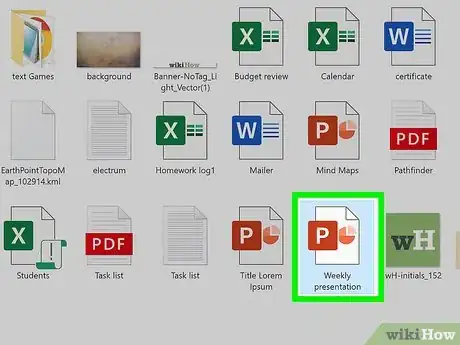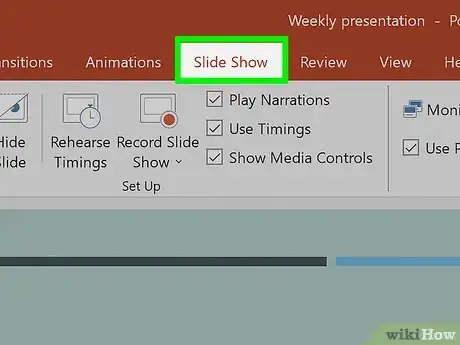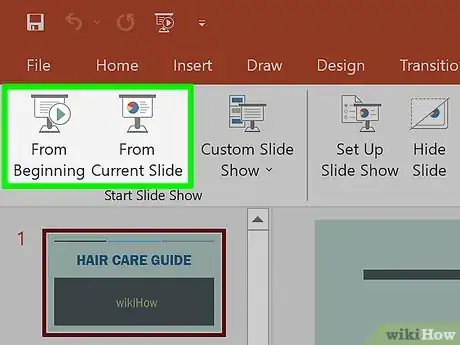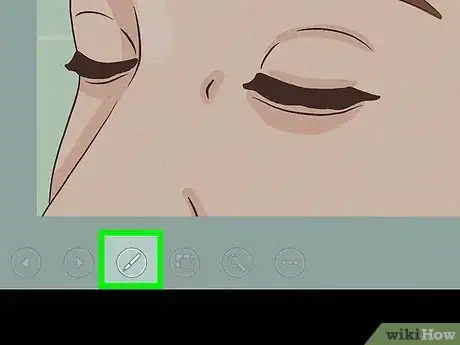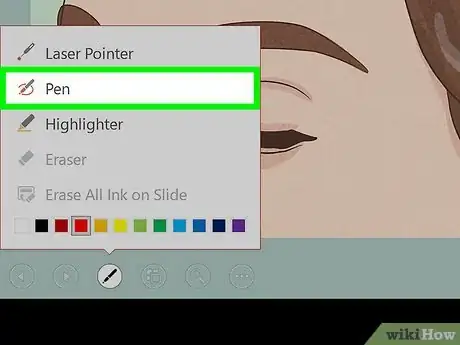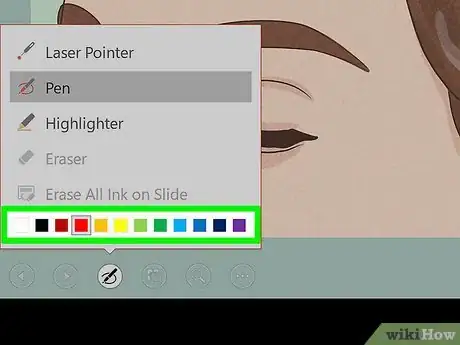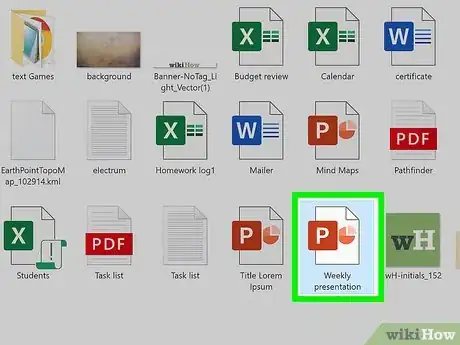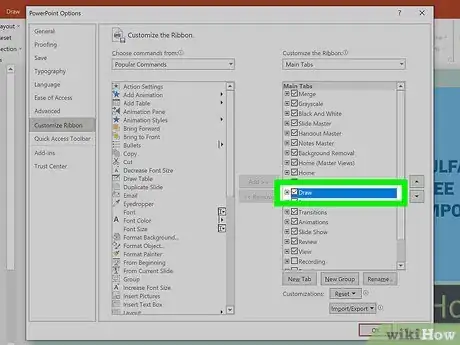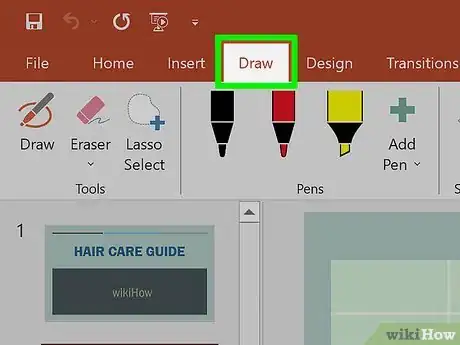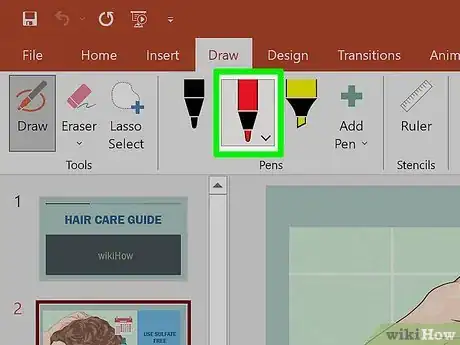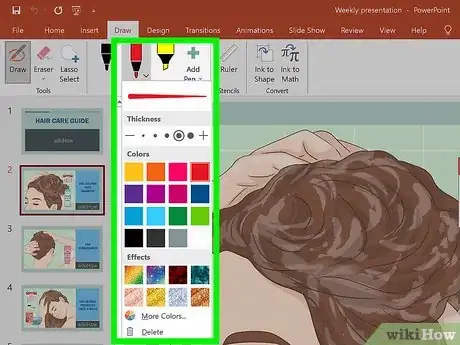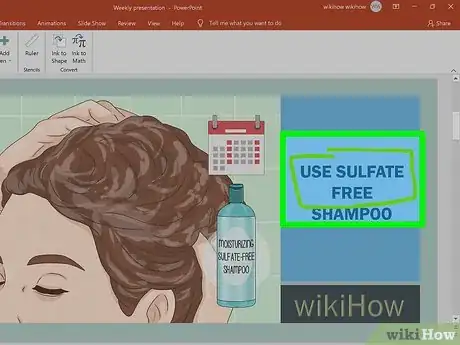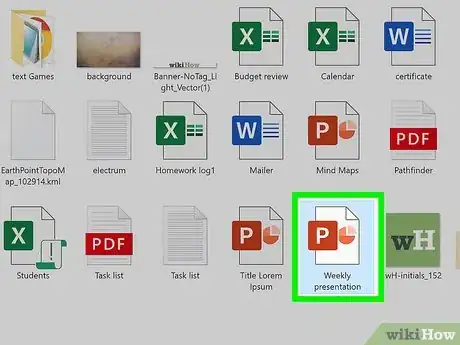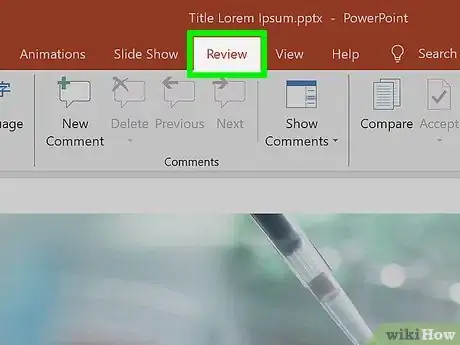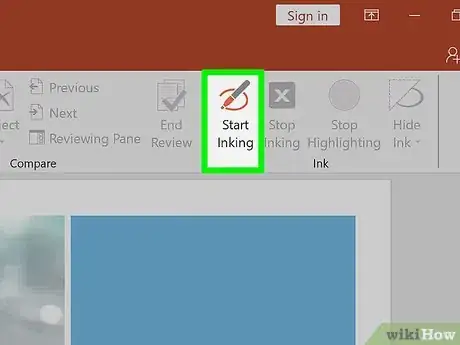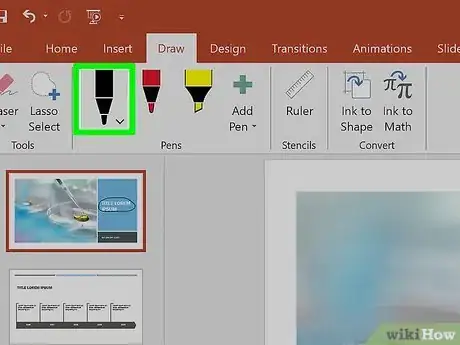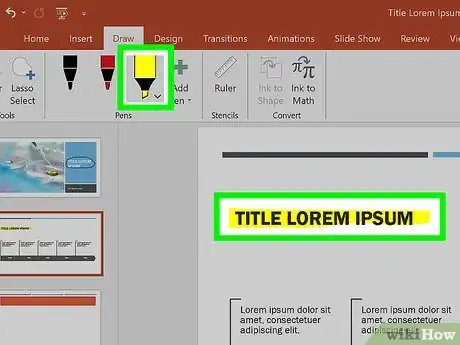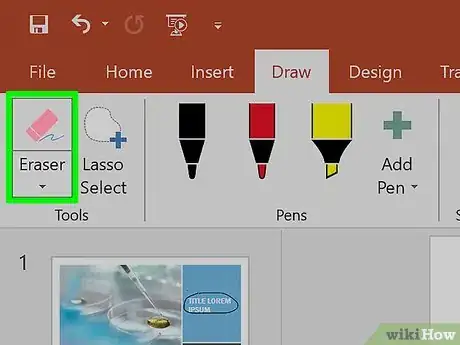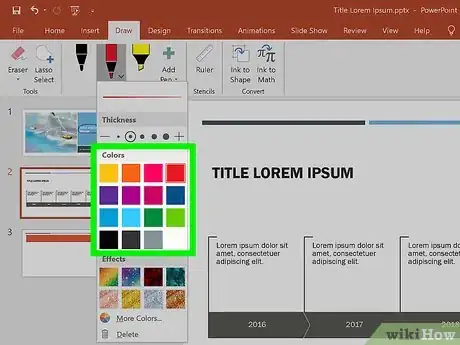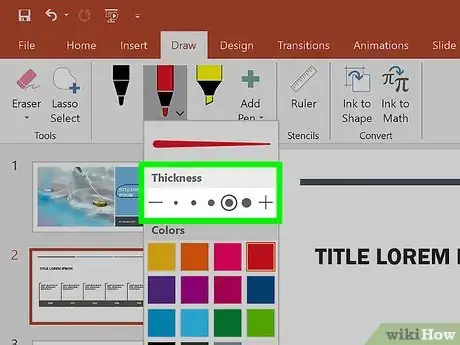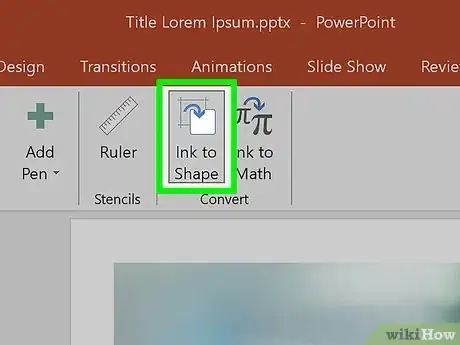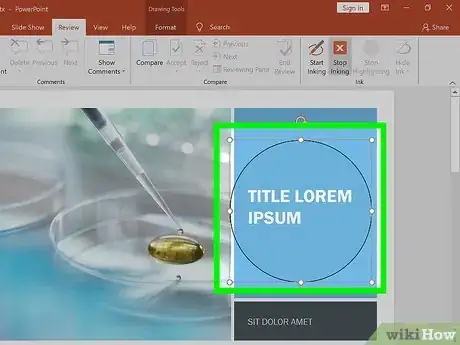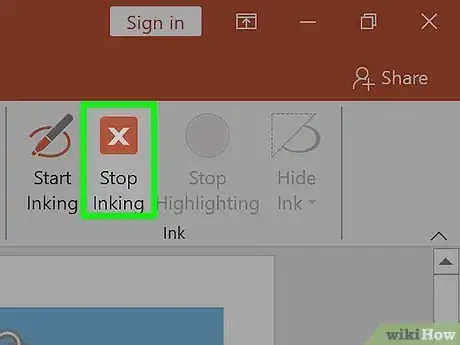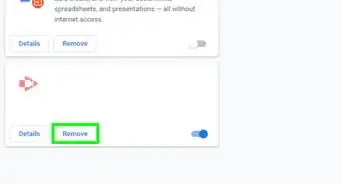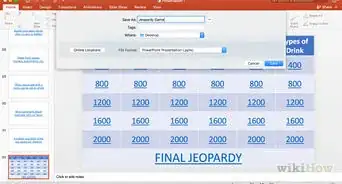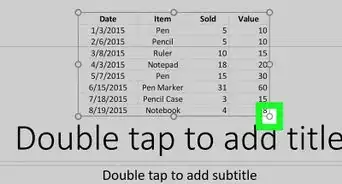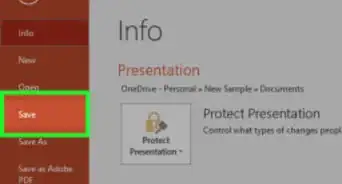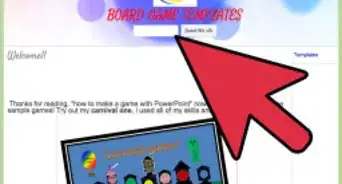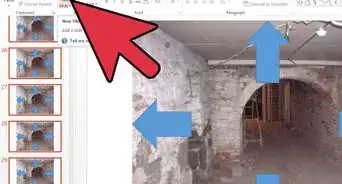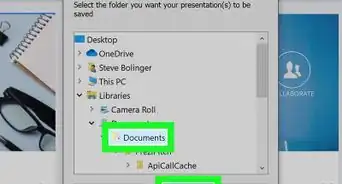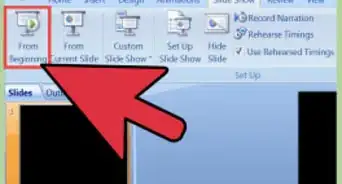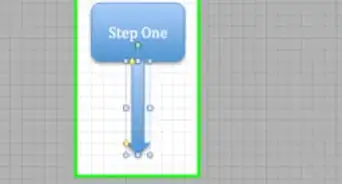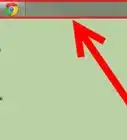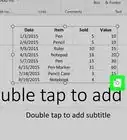This article was co-authored by wikiHow Staff. Our trained team of editors and researchers validate articles for accuracy and comprehensiveness. wikiHow's Content Management Team carefully monitors the work from our editorial staff to ensure that each article is backed by trusted research and meets our high quality standards.
The wikiHow Tech Team also followed the article's instructions and verified that they work.
This article has been viewed 362,164 times.
Learn more...
This wikiHow teaches you how to use your touchscreen, mouse, trackpad, or digital tablet to draw on PowerPoint slides. If you're using PowerPoint 2019 or later, you have a variety of drawing tools you can use while creating the slides, as well as during your presentation.
Steps
Drawing While Presenting (PowerPoint 2019 and Later)
-
1Open your presentation in PowerPoint. You can do so by double-clicking the presentation file on your PC or Mac.
-
2Click the Slide Show tab. It's at the top of PowerPoint.
- If you're using Windows, make sure the box next to "Use Presenter View" in the toolbar is checked.[1]
Advertisement -
3Start the presentation. You can click Play from Start or From Beginning to begin the slide show.
-
4Click the Pen icon. You'll see this icon at the bottom-left corner of the slide. A list of drawing tools will expand.
-
5Click Pen on the menu. This selects the Pen tool, which is the main drawing tool.
- If you'd rather use a translucent drawing tool, go for Highlighter instead.
-
6Select an ink color. The default color is red, but you can change it if you'd like. To do so, click the pen icon at the bottom-left again, select the Ink color or Pen color option on the menu, and then click the color you want to use.
-
7Draw with your mouse, finger, or digital tablet. Now you can draw on the current slide with the selected option. The options selected will stay the same as you proceed through the slide show.
- You'll be asked if you want to save your markings after the slide show is finished.
Drawing While Creating (PowerPoint 2019 and Later)
-
1Open your presentation in PowerPoint.
-
2Enable the Draw tab if it's not present (Windows only). If you don't see a tab called Draw at the top of PowerPoint, you'll need to enable it.[2] Here's how:
- Click the File menu at the top-left and choose Options.
- Click Customize Ribbon.
- Click Draw.
-
3Click the Draw tab. It's at the top of Word. This displays the Draw toolbar.
-
4Select one of the drawing tools. The options are in the Draw toolbar at the top. You can choose the pencil, one of the pens, or the highlighter, to get started.
-
5Click the drawing tool again to set your preferences. Clicking it a second time allows you to change its color and size, as well as choose from a gallery of special effects.
-
6Draw with your finger, mouse, or tablet. To start drawing, just click and drag the mouse, finger, or drawing tool.
- If you're using a trackpad on a Mac, you may find it helpful to turn on the "Draw with Trackpad" feature, which allows you to draw without having to hold down the mouse button at the same time. Click its switch on the Draw tab to toggle the feature on or off.
- You can switch between tools, colors, and sizes as you continue working on your illustration.
- If something didn't come out as you intended, click the down-arrow next to the eraser on the toolbar to find a variety of eraser tools.
- You can also use the Undo keyboard shortcut to undo your last stroke—just press Cmd + Z (Mac) or Ctrl + Z (Windows) to do so.
Drawing While Creating (PowerPoint 2016 and 2013)
-
1Open your presentation in PowerPoint. As long you have a touch-enabled PC or a compatible drawing tablet attached, you can use PowerPoint's inking tools to freehand draw on your slides. You can use your mouse to draw if you'd like, but your PC much be touchscreen-compatible to use this method.
- If your PC doesn't have a touchscreen or a compatible drawing tablet connected to the system, these tools will not work.
-
2Click the Review tab. This is on the menu bar at the top of PowerPoint.[3]
-
3Click Start Inking. This option is in the toolbar at the top of the screen.
- If the optioned is grayed-out, this won't work on your computer.
-
4Use the “Pen” to draw free-hand. Click the pen icon on the left side of the toolbar to choose this tool, which lets you make basic line drawings.
- You can use your touchscreen, touchpad, digital tablet, or mouse to draw with any of these tools.
-
5Use the “Highlighter” to draw transparent lines. This tool, which is to the right of the pen tool on the toolbar, acts as a thicker version of the pen with transparency. It allows you to ink over text or other drawings without covering them.
-
6Use the “Eraser” to remove drawn elements. After selecting, click and drag the cursor over other lines to erase the drawn content.
- Click the down arrow on the “Eraser” icon in the toolbar to select an eraser thickness.
-
7Change the tool color. Select the “Color” dropdown in the “Pens” section of the toolbar to select from a color palette for different pen/highlighter colors.
-
8Adjust your tool thickness. Select the Thickness dropdown in the “Pens” section of the toolbar to select different widths of your pen/highlighter marking.
- You can also select color/thickness presets from the menu to the left of the “Color” and “Thickness” dropdowns.
-
9Click Convert to Shapes (optional). This will auto-adjust any shape approximations into the detected shape. For example, drawing a circle, will adjust the lines to be a perfect circle. After choosing this option, draw the shape you want to make, and PowerPoint will automatically adjust it for you.
- The feature will also approximate a shape based on the number of lines drawn (square, hexagon, etc.).[4]
-
10Click the Lasso Select tool to select and move drawn items. This option in the toolbar allows you to click and drag drawn items to move them around on the screen.
-
11Click Stop Inking when you're finished drawing. This button will automatically returns to the regular PowerPoint Select tool after making edits with the pen or highlighter. If no edits were made this button will return you to the “Review” tab.
Community Q&A
-
QuestionHow do I get animations?
 Community AnswerThere should be a button on the top that says "Animations". Click on it to access animations in PowerPoint.
Community AnswerThere should be a button on the top that says "Animations". Click on it to access animations in PowerPoint.
References
- ↑ https://support.microsoft.com/en-us/office/draw-on-slides-during-a-presentation-80a78a11-cb5d-4dfc-a1ad-a26e877da770#OfficeVersion=Windows
- ↑ https://support.microsoft.com/en-us/topic/draw-and-write-with-ink-in-office-6d76c674-7f4b-414d-b67f-b3ffef6ccf53#OfficeVersion=Windows
- ↑ https://support.microsoft.com/en-us/topic/draw-and-write-with-ink-in-office-6d76c674-7f4b-414d-b67f-b3ffef6ccf53#OfficeVersion=Windows
- ↑ https://support.office.com/en-us/article/Use-a-pen-to-draw-write-or-highlight-text-on-a-Windows-tablet-6d76c674-7f4b-414d-b67f-b3ffef6ccf53
About This Article
PowerPoint's freehand drawing tools allow you to draw shapes on a slide as though you were using a pen or pencil. First, open your presentation in PowerPoint and select the slide you want to draw on. Click the "Insert" tab and select "Shapes" on the toolbar. To start drawing, you'll want to select the Freehand Scribble tool, which is the squiggly line in the "Lines" section of the menu. This expands the Format toolbar, which is where you'll find your drawing tools. To change the color and size of your drawing tool, scroll through the Shape Styles menu and select an option. Now you're ready to draw. Click and drag the mouse to draw the image. When you lift your finger from the mouse button, the object will be selected—you can adjust the size of the drawing by dragging any of the edges inward or outward. To fill in the drawn area, click the "Shape Fill" menu in the toolbar—you can fill it with a solid color, picture, gradient, or texture. You can also adjust the outline of your drawing using the "Shape Outline" menu—this lets you choose a custom color and line thickness, as well as change your line to one that's dotted, dashed, or arrowed. The Shape Effects menu contains 3D and other effects to add depth to your illustration—these effects look especially good when you're drawing solid, filled-in shapes. To draw another shape, click back to the "Insert" tab, return to the Shapes menu, and select the Freehand Scribble tool once more.
